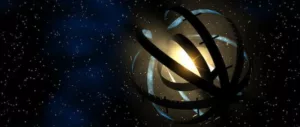A group of citizen scientists from the Planet Hunters project discovered an unusual light signal while looking through data collected by the Kepler space observatory. Observing the periodic dimming of a star is the best way to determine if it is being orbited by an exoplanet. Normally such planets dimm the star’s light by less than one percent, in a regular cycle, hinting at the planet’s orbital period.
The dimming pattern identified in KIC 8462852 suggested a massive clutter of objects orbiting the star, irregularly blocking up to 22 percent of its light. Scientists have no plausible explanation to what natural phenomenon could be the cause. They are sure that it is NOT a pulsing star, dust clouds caused by an asteroid or planetary collision or the effects of a nearby dwarf star. As Alan Duffy, Swinburne University astronomer, said. “It’s hard to imagine how you could block 20 per cent of light from a star. A star is huge. How do you block that much of it?”
A research group, assigned to look for “unambiguous indicators” of technology in the star system has renamed KIC 8462852 to WhatTheFlux 001 (WTF 001). At the moment scientists have only two explanations for WTF 001, either a very rare and unnatural formation of asteroids, or an alien mega-construction.
“When [I was shown] the data, I was fascinated by how crazy it looked,” explained Jason Wright, an astronomer from Penn State University, to The Atlantic. “Aliens should always be the very last hypothesis you consider, but this looked like something you would expect an alien civilization to build.”
The existing data was enough to convince SETI to use the radio telescope at Greenbank, West Virginia, to see if there are any clear signals of electromagnetic energy that could indicate radio technology. If they see any promising signs they will use the Very Large Array radio telescope in New Mexico to get a better picture.
I don’t know if our current technology can prove anything without the shadow of a doubt. We are either observing history in the making or the discovery of yet another unexplainable space phenomenon, time will show.








